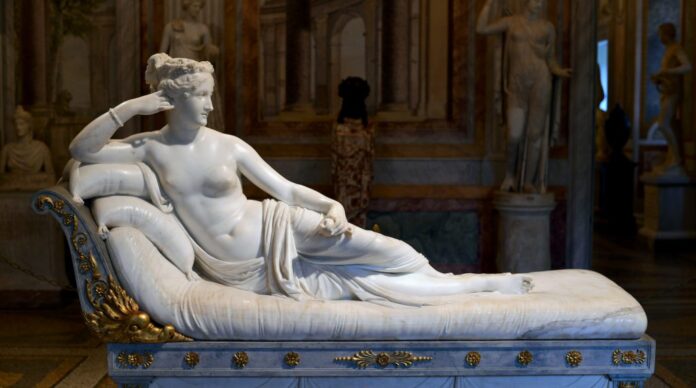A sexy sculpture of Napoleon’s sister by Antonio Canova became a reason for a scandal. Here are 3 facts that elevate it above sensationalism.
The sculpture of Pauline Borghese as the goddess Venus caused so much controversy that it was locked in a wooden box for decades.
Pauline Borghese modestly remarked about Venus the Victorious, an 1808 marble portrait by Antonio Canova depicting her as a victorious goddess of love that every veil must fall before Canova. The comment, which seemed to suggest that she had posed nude for the sculptor, immediately caused a sensation, although the scandal for Napoleon Bonaparte’s sister and Prince Camillo Borghese’s new fiancée was nothing new.
In 1805, when Antonio Canova began sculpting, Borghese was 25 years old. She was in her second marriage, after her first husband, General Charles Leclerc died of an illness in Santo Domingo. Napoleon sent the couple to a Caribbean island under the guise of military service, hoping to dispel rumors of his sister’s various romantic misdeeds in Europe.
Her marriage to the respected Borghese family, which took place just eight months after Leclerc’s death, further stirred up polite society. Camillo Borghese commissioned the sculpture in 1804. Despite the fact that the new marriage was already strained, Borghese was fascinated by the beauty of his wife and wanted the sculpture of the famous Antonio Canova to be exhibited privately. It should also be noted that Pauline and Camillo broke up before the sculpture was completed.
Antonio Canova, known for his level-headed character, generally disliked commissions for portraits and at first hoped to depict Pauline as Diana, the virgin goddess of the hunt. Pauline Borghese, perhaps better understanding her public persona, instead insisted on the goddess of love.
Venus Victrix, which is still on display in the Galleria Borghese in Rome, depicts Pauline lying on a sofa, topless, hair tousled, filled with jewelry, and looking away as if someone is only who entered the room.
This year marks the 200th anniversary of Antonio Canova’s death, so on Valentine’s Day, we decided to take a closer look at the portrait of Pauline Borghese.
Here are three fascinating facts that may change your mind about it.
A Portrait of Political Power

Antonio Canova, Napoleon as Mars the Peacemaker (1802–06). Collection of Apsley House, London
While the resting Venus may not seem like political propaganda at first glance, a close reading of the details of the sculpture hints at an alliance between the two most powerful families in Europe. Pauline Borghese holds a small apple in her left hand, an allusion to the myth of the Judgment of Paris, in which the mortal Paris, known for his justice, chooses Venus as the most beautiful goddess of Olympus, rewarding her with an apple.
Although the Borghese family did not appear in Rome until the 16th century, the family adopted the symbol of Venus, whose son Aeneas is said to have founded the city, as part of his ancestral mythology. In this sense, the image of Venus emphasized the long-standing political legitimacy of the family, supporting the alliance of Bonaparte and bringing the myth to life in the body of Pauline Borghese.
For the Bonaparte family, which was expanding its holdings across Europe, Borghese mythology strengthened the imperial claim to power. While at the turn of the 19th century Venus Victrix was read in the sense of “conquering men’s hearts”, the ancient motif originally had militaristic associations as a romanized version of the Greek Aphrodite Areia.
Antonio Canova Cast Her in Plaster

While any nude couple art of Pauline Borghese would have shocked the public, Canova’s sculpture was criticized in a very specific way: it was too realistic.
Canova’s methods for achieving such certainty were suspicious. Antonio Canova made a cast à vif, or cast of the Borghese body, which is in the collection of the Museo Antonio Canova in Possagno, Italy. This method, Van Eck writes, “was considered somewhat dubious because it was considered a sign of low skill on the part of the sculptor” and also caused “a whiff of scandal because of the closeness he assumed between the sculptor and his model.”
It Was Meant to Be Seen by Candlelight

While today art lovers can see Venus Victrix in the Villa Borghese during museum hours, the sculpture was actually meant to be admired in the evening by candlelight, as was the case in the late 18th and early 19th centuries. Moreover, the draped base of the sculpture originally contained a mechanism for its rotation. This mechanism was considered a fashionable way for spectators to observe the work from all angles without moving.

























